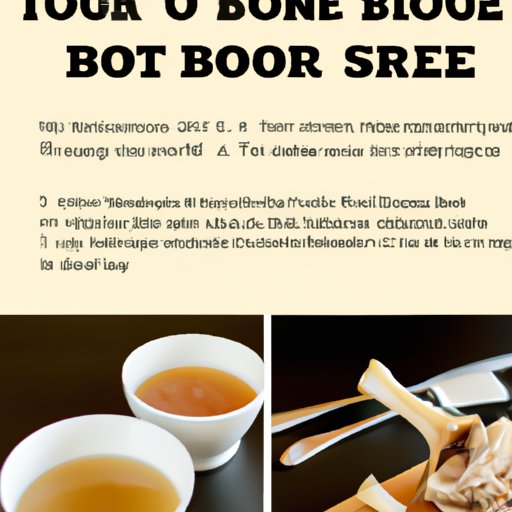Introduction
The Bone Broth Diet is a popular nutrition trend that has been gaining traction in recent years. It’s based on the idea of consuming large amounts of bone broth – a liquid made by simmering animal bones, vegetables, and spices in water – to achieve weight loss and other health benefits. In this article, we’ll explore what the Bone Broth Diet is, the potential benefits it offers, meal plan ideas, and tips for making your own bone broth at home.
Overview of the Bone Broth Diet: What It Is and How It Works
The Bone Broth Diet is a type of elimination diet that involves consuming large amounts of bone broth while avoiding certain foods like processed grains, dairy, and sugar. The diet is intended to help with weight loss and promote overall health by providing the body with beneficial nutrients such as collagen, amino acids, minerals, and electrolytes.
The Bone Broth Diet was created by Dr. Kellyann Petrucci, a naturopathic physician and certified nutrition consultant. According to her book, The Bone Broth Diet, the diet consists of three phases:
- Phase 1 (7-21 days): Eliminate specific foods from your diet, such as grains, dairy, legumes, and processed sugars, and replace them with bone broth and other approved foods.
- Phase 2 (2 weeks): Reintroduce eliminated foods one at a time to determine which ones may be causing digestive issues or other health problems.
- Phase 3 (ongoing): Continue eating an anti-inflammatory diet and incorporate bone broth into your meals to maintain health benefits.

Benefits of the Bone Broth Diet for Weight Loss and Health
The Bone Broth Diet has gained popularity due to its potential health benefits, including weight loss and improved digestion. Here are some of the potential benefits of the Bone Broth Diet:
The Benefits of Collagen
Bone broth is rich in collagen, a protein found in connective tissues such as skin, ligaments, and tendons. Consuming collagen can help support healthy joints, improve skin elasticity, reduce inflammation, and even boost metabolism, which can lead to weight loss.
A 2018 study published in the International Journal of Medical Sciences found that taking collagen supplements for eight weeks resulted in significant reductions in body fat percentage and waist circumference. The study concluded that collagen supplementation may be an effective way to reduce body fat and improve metabolic health.
Improved Gut Health
The gelatin in bone broth can help heal and seal the lining of the digestive tract, which can help improve gut health and reduce symptoms of leaky gut syndrome such as bloating, gas, and abdominal pain. Additionally, the amino acids in bone broth can help break down food and improve nutrient absorption.
A 2017 study published in the Journal of Functional Foods found that consuming chicken soup with added gelatin significantly reduced symptoms of leaky gut syndrome in participants. The study concluded that gelatin-rich soups may be beneficial for improving gut health.
Boosted Immune System
Bone broth is also high in essential vitamins and minerals, such as calcium, magnesium, phosphorus, and potassium, which can help boost the immune system. Additionally, bone broth contains the amino acid glutamine, which has been shown to have anti-inflammatory properties and can help support a healthy immune system.
A 2015 study published in the Journal of the American College of Nutrition found that glutamine supplementation reduced inflammation and improved immune function in participants. The study concluded that glutamine may be beneficial for reducing inflammation and boosting the immune system.

Meal Plan Ideas for the Bone Broth Diet
If you’re following the Bone Broth Diet, here are some meal plan ideas to get you started:
Breakfast Ideas
- Overnight oats with almond milk, chia seeds, and berries
- Smoothie bowl with banana, almond butter, and spinach
- Avocado toast with tomatoes and feta cheese
Lunch Ideas
- Salad with grilled chicken, quinoa, and roasted vegetables
- Soup with lentils, kale, and mushrooms
- Tuna salad with cucumbers, red onion, and spinach
Dinner Ideas
- Stir fry with beef, broccoli, and brown rice
- Grilled salmon with roasted sweet potatoes and asparagus
- Vegetable curry with chickpeas and cauliflower

Tips on Making Your Own Bone Broth at Home
Making your own bone broth at home is easy. Here are some tips to get you started:
Gather the Right Ingredients
To make bone broth, you’ll need animal bones (such as beef, poultry, or fish), vegetables (such as onions, carrots, and celery), herbs and spices (such as bay leaves and peppercorns), and filtered water.
Follow a Recipe
It’s best to follow a recipe when making bone broth to ensure it comes out flavorful and nutritious. There are many recipes available online, so take some time to find one that appeals to you.
Simmer for 8-24 Hours
Once the ingredients are in the pot, you’ll want to let the bone broth simmer for 8-24 hours. The longer it simmers, the more flavor and nutrients it will contain.
Possible Side Effects and Risks of the Bone Broth Diet
Although the Bone Broth Diet has many potential benefits, there are also some possible side effects and risks to consider. These include:
Lack of Essential Nutrients
The Bone Broth Diet eliminates many nutrient-rich foods, such as whole grains, legumes, and dairy, which could lead to deficiencies in important vitamins and minerals. To prevent nutrient deficiencies, it’s important to eat a variety of nutrient-dense foods.
High Sodium Intake
Bone broth is naturally high in sodium, which can increase blood pressure and put strain on the kidneys. If you’re following the Bone Broth Diet, it’s important to limit your intake of salty foods and drinks.
Potential Allergic Reactions
Some people may experience allergic reactions to ingredients in bone broth, such as shellfish, eggs, or nuts. If you have allergies, it’s important to check the ingredients list before consuming bone broth.
Conclusion
The Bone Broth Diet is gaining popularity for its potential health benefits, including weight loss and improved gut health. The diet is based on the idea of consuming large amounts of bone broth, which is rich in collagen, amino acids, minerals, and electrolytes. Additionally, bone broth can help heal and seal the lining of the digestive tract, boost the immune system, and reduce inflammation. Meal plan ideas for the Bone Broth Diet include overnight oats, smoothie bowls, salads, stir fries, and soups. Finally, it’s important to note that the Bone Broth Diet may lead to nutrient deficiencies, high sodium intake, and potential allergic reactions.
In conclusion, the Bone Broth Diet may offer a variety of potential health benefits, including weight loss, improved gut health, and a boosted immune system. However, it’s important to consult with a doctor or nutritionist before starting any new diet or nutrition plan. Additionally, it’s important to follow a balanced diet and incorporate a variety of nutrient-dense foods to ensure you’re getting all of the essential vitamins and minerals your body needs.
(Note: Is this article not meeting your expectations? Do you have knowledge or insights to share? Unlock new opportunities and expand your reach by joining our authors team. Click Registration to join us and share your expertise with our readers.)
